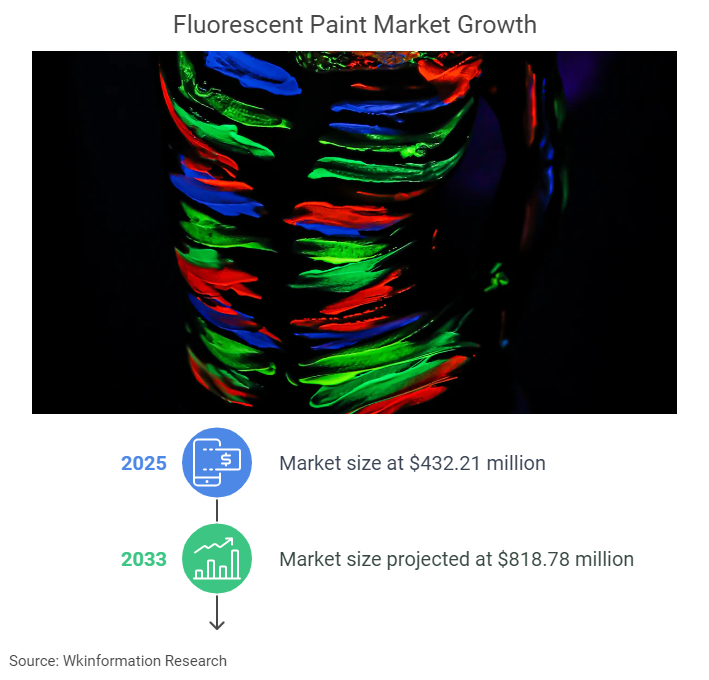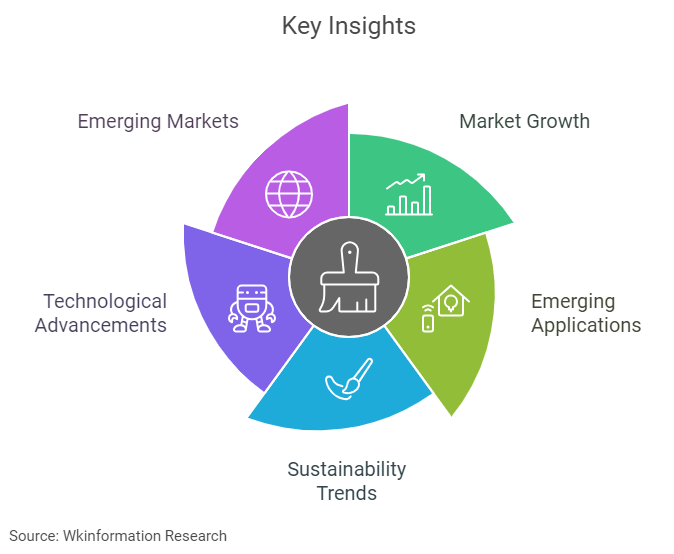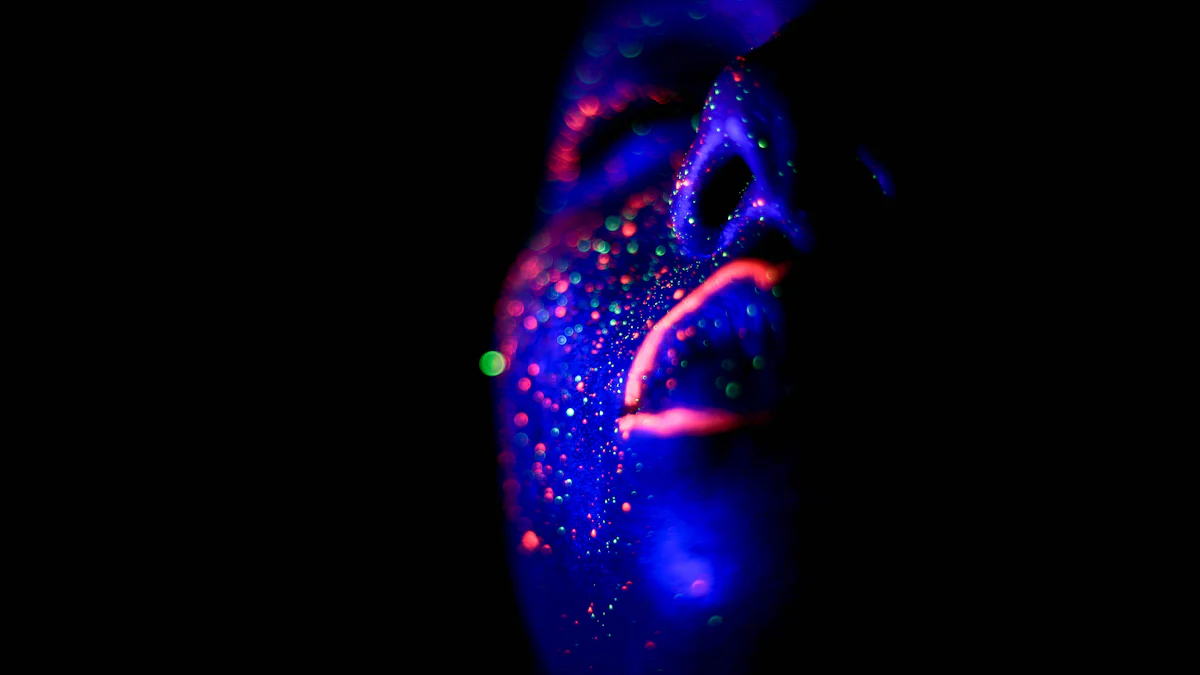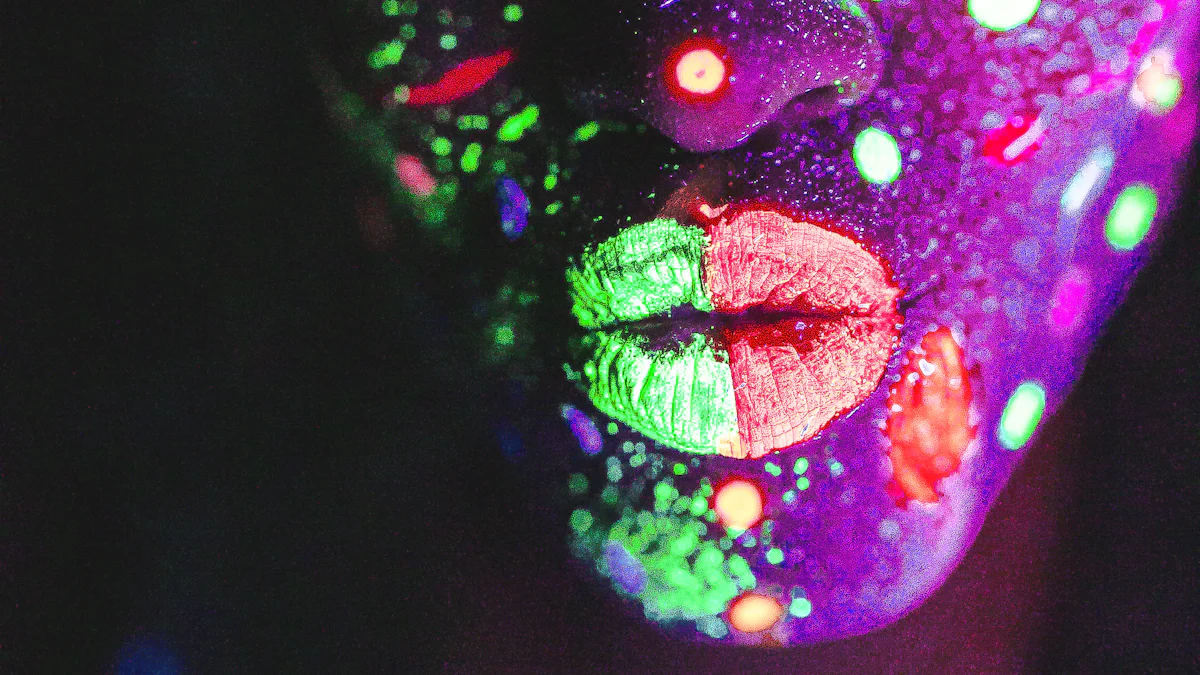
The global fluorescent paint market has experienced remarkable growth, driven by its widespread use across industries. Safety-focused sectors rely on these paints for hazard identification and road markings, while automotive customization employs them for unique designs. The market, valued at USD 432.21 million in 2025, is projected to reach USD 818.78 million by 2033, growing at a CAGR of 8.31%. Increasing demand for high-visibility solutions in low-light conditions and vibrant aesthetics continues to propel this expansion, making fluorescent paints indispensable in construction, transportation, and consumer goods.
Key Insights
- The global fluorescent paint market is projected to grow from $432.21 million in 2025 to $818.78 million by 2033, driven by increasing demand for safety and aesthetic applications across various industries.
- Emerging applications in sectors like interior design, consumer electronics, and aerospace are expanding the use of fluorescent paints, highlighting their versatility and innovative potential.
- Sustainability is a key trend, with manufacturers focusing on eco-friendly formulations, such as water-based paints with low VOC emissions, to meet consumer preferences and regulatory standards.
- Technological advancements, including smart coatings that respond to environmental changes, are enhancing the functionality and appeal of fluorescent paints in modern applications.
- Emerging markets, particularly in Asia-Pacific and Latin America, present significant growth opportunities due to rapid urbanization and increasing investments in infrastructure and safety.

Market Overview and Growth Projections

Fluorescent Paint Market Size and CAGR
The global fluorescent paint market is on a steady growth trajectory, with projections indicating significant expansion over the next decade. The market, valued at $432.21 million in 2025, is expected to grow at a compound annual growth rate (CAGR) of approximately 8.31% from 2025 to 2033. By 2033, the market valuation is anticipated to reach $818.78 million. This growth reflects the increasing adoption of fluorescent paints across various industries, including construction, automotive, and consumer goods.
The luminous paint market is also witnessing robust growth. This trend highlights the rising demand for innovative and high-visibility solutions in both commercial and residential applications.
Key Drivers of Market Growth
Several factors are driving the expansion of the fluorescent paint market. The construction and automotive industries are leading contributors, leveraging fluorescent paints for safety and aesthetic purposes. Heightened awareness of safety and security has further fueled demand, particularly in applications such as road markings and hazard identification.
The growing popularity of fluorescent paints in art and decoration also plays a pivotal role. These paints offer vibrant and luminous effects, making them a preferred choice for creative projects. Additionally, advancements in paint technology have enhanced durability and brightness, further boosting their appeal across industries.
Emerging Applications in the Luminous Paint Market
The luminous paint market is diversifying rapidly, with emerging applications contributing to its growth. Key sectors benefiting from these innovations include:
- Interior Design and Home Decor: Luminous paints are increasingly used to create unique designs on walls and furniture.
- Consumer Electronics: These paints enhance usability by illuminating buttons and logos on devices in low-light conditions.
- Aerospace and Aviation: Fluorescent paints ensure visibility of emergency exits and navigational elements in low-visibility environments.
The global fluorescent paint market continues to evolve, driven by these diverse applications and the growing need for innovative solutions.
Market Segmentation
By Type
Water-Based Fluorescent Paints
Water-based fluorescent paints are gaining popularity due to their eco-friendly composition and ease of application. These paints emit visible light when exposed to ultraviolet or blue light, making them ideal for safety and decorative purposes. Their water-soluble nature ensures low toxicity, making them suitable for indoor applications such as murals, interior decor, and artistic projects. Additionally, water-based paints are less prone to emitting volatile organic compounds (VOCs), aligning with the growing demand for sustainable solutions in the luminous paint market.
Solvent-Based Fluorescent Paints
Solvent-based fluorescent paints, known for their durability and resistance to environmental stressors, are widely used in outdoor applications. These paints absorb both visible and non-visible light, re-emitting it at different wavelengths to create vibrant effects. Industries such as automotive and construction rely on solvent-based paints for road markings, hazard identification, and vehicle customization. Despite their effectiveness, these paints face scrutiny due to their higher VOC content, prompting manufacturers to innovate with low-emission alternatives.
By Application
Safety and Visibility
Fluorescent paints play a critical role in enhancing safety and visibility across various sectors. They are extensively used for road markings, traffic signs, and emergency lighting systems, ensuring visibility for drivers and pedestrians. In industrial settings, these paints mark hazardous areas and machinery, promoting worker safety. Personal protective equipment (PPE) like helmets and vests also incorporate fluorescent coatings to improve visibility in low-light environments, addressing the growing demand for safety solutions in the global fluorescent paint market.
Decorative and Aesthetic Uses
The luminous properties of fluorescent paints make them a favorite among artists, designers, and decorators. These paints add a dynamic dimension to murals, sculptures, and interior decor, attracting both commercial and residential customers. In the entertainment industry, fluorescent paints create immersive experiences at events, concerts, and parties. Their vibrant colors also appeal to hobbyists and DIY enthusiasts, who use them for crafts and creative projects. The luminous paint market continues to thrive as emerging trends in art and design fuel demand for these versatile products.
By End-Use Industry
Construction and Infrastructure
The construction industry remains a significant consumer of fluorescent paints. These paints are applied to construction zones, traffic lanes, and machinery to enhance safety and visibility. Their resistance to fading ensures durability against environmental stressors, making them indispensable for outdoor applications. As infrastructure projects expand globally, the demand for luminous paints in this sector is expected to grow.
Automotive and Transportation
In the automotive sector, fluorescent paints enhance both safety and aesthetics. Vehicle designs incorporate these paints for customization and brand recognition, while safety markings improve visibility in low-light conditions. The transportation industry also uses fluorescent coatings for signage and emergency exits, ensuring passenger safety. These applications highlight the critical role of luminous paints in this industry.
Consumer Goods and Retail
Fluorescent paints have found a niche in the consumer goods and retail sectors. They are used to decorate shop fronts, interior spaces, and product displays, creating eye-catching visuals that attract customers. The vibrant and luminous properties of these paints also make them popular in textiles, where they enhance visibility in low-light conditions. As consumer preferences shift toward bold and dynamic designs, the luminous paint market continues to expand in this industry.
Regional Analysis
Leading Markets in the Fluorescent Paint Market
North America
North America dominates the global fluorescent paint market, holding the largest share due to its robust industrial applications and creative sectors. Technological advancements and widespread adoption in safety and decorative applications drive this growth. Industries such as automotive and construction heavily rely on fluorescent paints for visibility and aesthetics. Additionally, the region benefits from a strong regulatory framework that supports innovation in luminous paint formulations.
Europe
Europe ranks as the second-largest market. The region’s focus on innovative aesthetics in design and construction fuels demand for luminous paints. Governmental support for sustainable and eco-friendly products further strengthens the market. European industries integrate fluorescent paints into infrastructure projects and creative designs, enhancing their appeal in both commercial and residential sectors.
Emerging Markets in the Luminous Paint Market
Asia-Pacific
Asia-Pacific represents the fastest-growing region in the luminous paint market. Rapid industrialization, urbanization, and rising disposable incomes contribute to this expansion. The automotive sector plays a pivotal role, utilizing luminous paints for safety and customization. Urban development projects and increasing demand for decorative applications further boost the market’s growth.
Latin America
Latin America emerges as a promising market, with countries like Brazil leveraging luminous paints in street art and cultural festivals. These applications enhance local culture and attract international attention. Urban development projects and safety initiatives also drive demand. However, the perception of luminous paints as niche products presents a challenge for widespread adoption.
Regional Growth Drivers and Challenges
The global fluorescent paint market exhibits diverse growth dynamics across regions. While North America and Europe lead in technological advancements and sustainability, Asia-Pacific and Latin America offer untapped potential driven by urbanization and cultural applications. Addressing regulatory challenges and market perceptions will be crucial for sustained growth in emerging markets.
Key Trends and Innovations

Technological Advancements in Fluorescent Paints
The luminous paint market has seen significant technological advancements, enhancing both performance and usability. Manufacturers have developed more durable formulations that resist environmental stressors, ensuring long-lasting vibrancy. Improved UV resistance prevents fading, making these paints ideal for outdoor applications. Innovations in application methods, such as sprayable and quick-drying options, simplify usage across industries.
Nanotechnology has introduced anti-counterfeiting solutions, enabling fluorescent paints to emit broader spectrums or change color based on temperature. These advancements cater to industries like automotive and consumer goods, where customization and security are paramount. As technology evolves, the global fluorescent paint market continues to benefit from enhanced functionality and versatility.
Sustainability and Eco-Friendly Paints
Sustainability has become a driving force in the luminous paint market. Manufacturers are prioritizing eco-friendly formulations, including water-based paints with low volatile organic compound (VOC) emissions. These products reduce environmental impact while maintaining high performance. Recyclable and sustainable packaging further aligns with eco-conscious consumer preferences.
The increasing focus on sustainability has spurred growth in the fluorescent paint market. Companies are responding to demand by creating non-toxic alternatives that meet regulatory standards. These efforts not only address environmental concerns but also open new opportunities in markets emphasizing green practices.
Integration of Fluorescent Paints in Smart Technologies
Emerging trends in the luminous paint market highlight the integration of smart technologies. Fluorescent paints now incorporate features that respond to environmental changes, such as temperature or light intensity. These smart coatings find applications in safety equipment, automotive designs, and even wearable technology.
The automotive industry, particularly electric vehicles, has embraced these innovations for safety markings and aesthetic enhancements. Additionally, smart fluorescent paints are gaining traction in DIY and decorative markets, where personalization trends dominate. This integration of technology positions the luminous paint market as a key player in future-ready solutions.
Competitive Landscape
Major Players in the Fluorescent Paint Market
The global fluorescent paint market features a diverse range of key players, each contributing to its dynamic growth. These companies operate across various regions, offering innovative products tailored to industry demands. The following table highlights some of the major players in this competitive landscape:
- Radiant Color N.V.
- LuminoChem
- Ronan Paints
- Glow Paint Industries
- GLOWTEC LTD
- Krylon Products Group
- DayGlo Color Corp
- Brilliant Group, Inc.
- Aron Universal Limited
- Vicome Corp
- Midstar
- Xcolor
- DANE Color Group
- Solar Color Dust
Additionally, prominent companies such as Kansai Paint, PPG Industries, and AkzoNobel have established themselves as leaders through their extensive product portfolios and global reach. These organizations continuously invest in research and development to maintain their competitive edge.
Strategies for Growth and Innovation
Leading companies in the fluorescent paint market employ various strategies to sustain growth and foster innovation. Product differentiation remains a core focus, with manufacturers introducing advanced formulations that cater to evolving customer preferences. Many firms prioritize sustainability by developing eco-friendly paints with low VOC emissions, aligning with global environmental standards.
Investments in novel applications, such as marine coatings and consumer electronics, enable companies to diversify their offerings. Innovations in fluorescent pigment technology have also enhanced durability and UV resistance, ensuring vibrant colors remain intact over time. These advancements not only improve product performance but also attract new customers in emerging markets.
Recent Mergers, Acquisitions, and Partnerships
Collaborations and strategic alliances play a crucial role in shaping the competitive analysis of the luminous paint market. Recent developments include:
- European companies focusing on mergers and acquisitions to drive product development.
- Expansions and product launches aimed at strengthening market presence.
- Partnerships designed to enhance technological capabilities and explore new applications.
These activities highlight the industry’s commitment to growth and innovation. By leveraging synergies, companies can expand their market share and address the increasing demand for luminous solutions.
Opportunities and Challenges
Growth Opportunities in Emerging Markets
Emerging markets present high growth opportunities for the global fluorescent paint market. Rapid industrialization and urbanization in regions like Asia-Pacific and Latin America have created a surge in demand for high-visibility markings and signage. Government investments in infrastructure and safety improvements further amplify this demand. The growing construction sector, driven by stringent safety regulations, continues to be a significant contributor to the luminous paint market’s expansion.
Innovations in eco-friendly formulations attract environmentally conscious consumers in these regions. Diversification into new applications, such as marine coatings and sports equipment, also opens new avenues for growth. The rising popularity of DIY culture and artistic applications enhances the market’s appeal, particularly among younger demographics. Customization trends allow manufacturers to offer tailored solutions, meeting specific customer needs across industries like automotive, safety signage, and entertainment.
Challenges in Raw Material Costs and Regulations
The fluorescent paint market faces notable challenges related to raw material costs and regulatory compliance. Stringent restrictions on certain pigments, due to their toxicity and environmental impact, limit formulation options in specific regions. Compliance with these regulations increases production costs, making it difficult for manufacturers to maintain competitive pricing.
Environmental and health concerns surrounding volatile organic compounds (VOCs) in traditional luminous paints further complicate production. VOCs contribute to air pollution and pose health risks, prompting stricter regulations. These challenges require manufacturers to innovate with low-VOC and sustainable alternatives to remain competitive.
Addressing Environmental Concerns
Environmental concerns in the luminous paint industry are being addressed through significant advancements in product formulations. Manufacturers are developing low-VOC and water-based paints that reduce air pollution and health risks. These eco-friendly options align with global sustainability goals and consumer preferences.
Recyclable packaging and the elimination of harmful substances in paint formulations further demonstrate the industry’s commitment to eco-conscious practices. By adopting these measures, companies not only address environmental challenges but also unlock opportunities in markets prioritizing green solutions. These efforts position the global fluorescent paint market as a leader in sustainable innovation.
Overview
The global fluorescent paint market demonstrates robust growth potential, driven by technological advancements and rising demand across industries. Emerging economies, particularly in Asia-Pacific, are expected to play a pivotal role in market expansion due to increasing per capita income and urbanization. The shift toward eco-friendly products aligns with consumer preferences and regulatory standards, fostering innovation. However, environmental concerns regarding heavy metal usage may challenge the expected growth rate. Industry players must prioritize sustainability and product innovation to capitalize on lucrative opportunities in untapped regions and diverse applications.
| Report Attributes | Details |
|---|---|
| Base Year | 2024 |
| Market Size 2025 | 432.21 Million USD |
| Market Size 2033 | 818.78 Million USD |
| CAGR | 8.31% |
| Historical Year | 2019 – 2024 |
| Forecast Year | 2025 – 2033 |
| Report Coverage | Revenue Forecast, Market Competitive Landscape, Growth Factors, and Trends |
| Segments Covered | Type, Applications, and Region |
| Geographies Covered | North America, Europe, Asia Pacific, and the Rest of the World |
FAQ
What is driving the growth of the fluorescent paint market?
The fluorescent paint market is expanding due to its applications in safety, construction, and automotive industries. Increasing demand for high-visibility solutions and vibrant aesthetics contributes to this growth. Technological advancements and eco-friendly formulations further enhance its appeal across diverse sectors.
Which regions offer the most potential for market expansion?
Asia-Pacific and Latin America present significant opportunities for market growth. Rapid urbanization, industrialization, and rising disposable incomes drive demand in these regions. Government investments in infrastructure and safety initiatives further support the market’s expansion.
How are manufacturers addressing environmental concerns?
Manufacturers are developing eco-friendly, water-based paints with low VOC emissions to reduce environmental impact. Sustainable packaging and non-toxic formulations align with global sustainability goals. These innovations address environmental challenges while meeting consumer preferences for green solutions.
What are the key challenges in the fluorescent paint market?
The market faces challenges such as fluctuating raw material costs and stringent regulations on chemical usage. Compliance with environmental standards increases production costs. Limited formulation options in certain regions also restrict product availability.
What is the growth forecast for the fluorescent paint market?
The fluorescent paint market is projected to grow at a CAGR of 8.31% from 2025 to 2033. By 2033, the market valuation is expected to reach $818.78 million, driven by increasing demand across industries and advancements in paint technology.
Global Fluorescent Paint Market Report – Table of Contents
1 Market Study Overview
2 Basic Product Information
3 Market Analysis
4 Fluorescent Paint Related Market Analysis
5 Global Trend Summary
6 Competition by Manufacturer
7 Analysis of Key Players
8 Global Fluorescent Paint Revenue, Sales Categorized by Regions
9 North America Fluorescent Paint Market Size Categorized by Countries
10 Europe Fluorescent Paint Market Size Categorized by Countries
11 Asia-pacific Fluorescent Paint Market Size Categorized by Countries
12 South America Fluorescent Paint Market Size Categorized by Countries
13 Middle East and Africa Fluorescent Paint Market Size Categorized by Countries
14 Global Fluorescent Paint Industry Segment Analysis
15 Global Fluorescent Paint Market Forecast
16 Research Findings and Conclusion
17 Appendix


